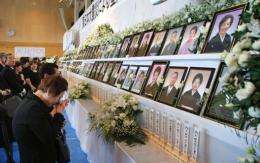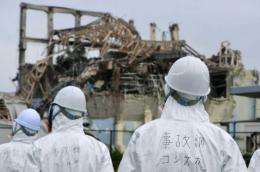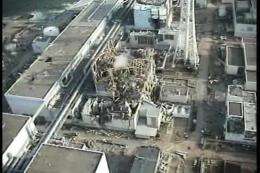Relatives of earthquake and tsunami victims pray at an altar during a ceremony in the Tairatoyoma area of Iwaki, where 85 people were confirmed dead and missing, in Fukushima Prefecture on Sunday. Tokyo Electric Power Co. Sunday will open a second reactor building at the Fukushima nuclear power plant to send repair crews inside for the first time since it was crippled.
Tokyo Electric Power Co. said it will open a second reactor building at the stricken Fukushima nuclear power plant to send repair crews inside for the first time since it was crippled.
Of the six reactors at the Fukushima Daiichi plant, reactors one to four were heavily damaged by the 9.0-magnitude earthquake and deadly tsunami on March 11.
Last month, TEPCO opened a door for the structure housing reactor number one, and began work to build a system to cool it stably.
Junichi Matsumoto, TEPCO's nuclear official said the entrance to the reactor number two building would slowly be opened from Sunday evening "to make sure dust inside the building will not fly away".
"We believe this action should result in no impact to the environment," he said, adding that it should lower the 99.9-percent humidity inside the building.
Members of a Japanese government panel inspect the damage at the Tokyo Electric Power Company (TEPCO) Fukushima nuclear power plant on June 17, 2011 in Okuma town, Fukushima prefecture.
Workers will then enter the facility to check on measuring tools inside and eventually start work to inject nitrogen into the reactor to prevent an explosion.
The world's worst nuclear accident since Chernobyl in 1986 has caused radioactive material to spew into the air, ground and sea and forced the evacuation of 80,000 people in a 20-kilometre (12-mile) radius.
Workers have pumped water into reactor cores and fuel rod pools, leaving more than 100,000 tonnes of contaminated water in basements, drains and ditches, some of which has leaked into the ocean.
More than four out of five Japanese want to see Tokyo abandon nuclear power in the wake of the Fukushima atomic crisis, a survey said Sunday.
Resource-poor Japan relies on nuclear power for a third of its electricity supplies, and Prime Minister Naoto Kan's government has said it will remain a major pillar of the nation's energy policy.
But a survey in the Tokyo Shimbun newspaper found that 82 per cent of Japanese wanted to see it phased out.
An aerial view of TEPCO's No.1 Fukushima nuclear power plant at Okuma. Of the six reactors at the Fukushima Daiichi plant, reactors one to four were heavily damaged by the 9.0-magnitude earthquake and deadly tsunami on March 11.
Just over nine percent wanted all reactors shut down immediately, while almost 19 percent said they should each be permanently decommissioned when their next routine inspection was due.
The majority, just under 54 per cent, wanted to have them shut down when electricity supply and demand allowed.
Only 14 percent wanted no change.
"The survey reflected the strength of the public's distrust in the government's nuclear policy," the newspaper said.
(c) 2011 AFP


























